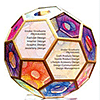CUET Maths syllabus 2023 covers topics such as algebra, time series, application of integrations, probability, index numbers, linear programming, and more. Candidates can download the official PDF and follow the preparation tips to ace the exam.
CUET Maths syllabus 2023 covers topics such as algebra, calculus, probability, 3-D geometry, time series, linear programming, and more. Most of the syllabus of CUET Maths is based on class XII topics. The section-wise CUET Maths syllabus is provided here, along with test pattern details and exam preparation tips.
| CUET Admit Card 2023 | CUET Exam Pattern 2023 |
CUET Maths Syllabus 2023
CUET Maths syllabus 2023 is categorised into three sections: Section A, Section B1, and Section B2. Each of these sections involve a variety of topics. The detailed section-wise syllabus of CUET Maths is given below.
Section A
Algebra
- Matrices and types of Matrices
- Equality of Matrices, transpose of a Matrix, Symmetric, and Skew Symmetric Matrix
- Algebra of Matrices
- Determinants
- Inverse of a Matrix
- Solving simultaneous equations using Matrix Method
Calculus
- Higher order derivatives
- Tangents and Normals
- Increasing and Decreasing Functions
- Maxima and Minima
Applications of Integrations
- Indefinite integrals of simple functions
- Evaluation of indefinite integrals
- Definite Integrals
- Application of Integration as an area under the curve
| CUET Exam Day Guidelines 2023 | CUET Passing Marks 2023 |
Differential Equations
- Order and degree of differential equations
- Formulating and solving differential equations with variable separable
Distribution of Probabilities
- Random variables and their probability distribution
- Expected value of a random variable
- Variance and Standard Deviation of a random variable
Linear Programming
- Mathematical formulation of Linear Programming Problem
- Graphical method of solution for problems in two variables
- Feasible and infeasible regions
- Optimal feasible solution
| CUET Merit List 2023 | CUET Marks vs Percentile |
Section B1: Mathematics
Relationships and Functions
- Relations and functions: Included is a one-to-one mapping, composite functions, reflexive, transitive, symmetric, and equivalence relations, as well as binary operations.
- Functions of inverse trigonometry: Inverse trigonometric functions include several subjects, including determining range, domain, and principal value and creating graphs of inverse functions.
Algebra
- Matrices: This chapter covers the fundamental ideas of matrices, notation, order of operations, zero matrices, and matrix transposition. Row and column operations knowledge, non-commutativity of matrix multiplication, and properties of addition and multiplication of scalar matrices are also covered in this chapter.
- Determinants: In the first section of the chapter, significant properties of determinants, estimating cofactors, and employing properties of determinants in estimating a triangle's area are covered. The adjoint and inverse of the square matrix are discussed in the second section of the chapter, along with checking for consistent and inconsistent answers to linear equations and utilizing the inverse approach to solve equations involving more than two variables.
Calculus
- Continuity and Differentiability: The derivatives of composite functions, the derivative of inverse functions, the use of the chain rule approach, and determining the derivative of an implicit function are covered in the first few sections of the chapter. Exponential and logarithmic functions, logarithmic differentiation, derivatives of parametric functions, Rolle's and Lagrange's Mean Value Theorem, and their applications are covered in the chapter's latter sections.
- Application of Derivatives: The estimation of the rate of change of growing and decreasing functions, tangent and normal ideas, and maxima and minima functions, including the first and second derivative tests, are some of the subjects covered in the first section. This chapter's latter section has some problem sums on tangents and normals that are of an advanced level.
- Integrals: The differentiation method and the integration approach are considered opposites. The two main ways of integration that can be used depending on convenience are integration by substitution and parts. This chapter also covers the basic characteristics of definite integrals and some of their uses.
- Applications of Integrals: Integrals are used in this chapter to calculate the areas of circles, ellipses, and parabolas.
- Differential equations: The simple definition, degree, and order of equations, as well as the formulation of differential equations with indicated solutions, are covered in the first section of the differential equations chapter. Finding solutions to first-order homogeneous differential equations, solving linear differential equations, and the separation of variables approach are all included in the second section.
3-D Geometry and Vectors
- Vectors: The first section of the chapter discusses vectors, including their magnitude and direction, direction cosines, collinearity, and the vectors' addition and multiplication by scalars. The next portion of the textbook covers scalar triple products, cross products of vectors, vector dot products, and problem sums on the projection of a vector on a straight line.
- 3-D geometry: Estimating ratios, determining the shortest distance between any two lines, constructing cartesian and vector equations of a line, and calculating the angle between two lines, planes, and a line and a plane are all aspects of three-dimensional geometry.
Linear Programming
- The first section of Linear programming covers mathematically expressing linear programming issues, optimization strategies, and using graphical tools to solve equations with two variables.
- Finding the best solutions up to three non-trivial restrictions and identifying the feasible and infeasible solutions are included in the second section.
Probability
- The Bayes theorem, conditional probability theorem, and multiplication theorem on probability are all included in the chapter's first section.
- A random variable, its probability distribution, repeated independent trials, and binomial distribution are all included in the second section of the chapter.
- The chapter's third section, which deals with problem sums, assumes that the reader has already read the first two sections.
Section B2: Applied Mathematics
Numbers, Quantification, and Numerical Applications
- Modulo Arithmetic
- Congruence Modulo
- Mixture and Allegation
- Numerical Problem Sums
- Boats and Streams
- Pipes and Cisterns
- Races and Games
- Partnership Inequalities.
Algebra
- Matrices
- Transpose of a Matrix,
- Symmetric and Skew-symmetric Matrix.
Calculus
- Higher-order Derivatives
- Marginal Cost and Marginal Revenue
- Maxima and Minima.
Probability Distributions
- Probability Distribution
- Mathematical Distribution
- Variance.
Index Numbers and Time-Based Data
- Index numbers
- Construction of Index Numbers
- Application of time-reversal test.
Probability
- Population and sample
- Parameter and statistics and statistical inferences.
Time Series
- Components of time series using time series analysis for univariate data.
Financial Mathematics
- Perpetuity
- Bond valuation method
- Estimating EMI
- Calculating depreciation through a linear method.
Linear Programming
- Introduction and steps to form linear programming problems
- Distinguishing between different types of linear programming problems
- Graphical method for finding solutions
- Shading feasible, bounded, and infeasible region.
| CUET Maths Syllabus PDF | Download Now |
CUET Maths Syllabus Exam Pattern
As students have CUET Mathematics syllabus 2023. Let us now look into the CUET Maths exam pattern so that students are well aware of the paper structure before appearing for the actual examination.
| Particulars | Details |
| Total questions asked | 85 |
| Total questions to be attempted | 65 |
| Type of Questions | MCQs |
| Exam Duration | 45 Minutes |
| Exam Mode | Online (CBT) |
| Exam Frequency | Once a year |
| Marking Scheme |
|
Read More: CUET Exam Pattern 2023
CUET Maths Syllabus 2023 Preparation Tips
Given how much practice it requires, the CUET Maths syllabus 2023 is regarded as the most challenging subject among all the others. Therefore, here are some of the tips that can come in handy for the candidates:
- Candidates must constantly practice the topics to be able to tackle various types of questions in Mathematics.
- The candidate must know the curriculum's concepts to practice the problem sums.
- The preceding section has given an extensive summary of the CUET Maths syllabus 2023 and exam format. Interested students should carefully read the syllabus.
- Additionally, candidates should frequently practice sample papers and previous year's question papers to identify common and high-weightage topics.
- Nonetheless, appearing for mock tests for the CUET Maths syllabus 2023 can be beneficial.
Read More: CUET Preparation Tips 2023























